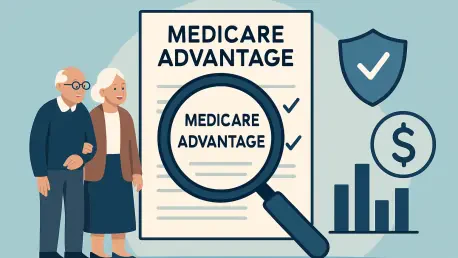As we dive into the evolving landscape of healthcare policy, I’m thrilled to sit down with James Maitland, a renowned expert in healthcare regulation with a deep focus on Medicare Advantage plans. With years of experience analyzing policy impacts and advocating for transparency, James offers invaluable insights into the recent CMS final rule that mandates Medicare Advantage plans to share provider directories on the Medicare Plan Finder. In this conversation, we explore how this rule aims to empower seniors with better information, the challenges of implementation, the persistent issue of inaccurate provider data, and the broader push for transparency in healthcare networks.
Can you walk us through the core purpose of the new CMS final rule on Medicare Advantage plans?
Absolutely. The CMS final rule, recently rolled out, focuses on increasing transparency for seniors by requiring Medicare Advantage plans to publish their provider directories directly on the Medicare Plan Finder. This is a significant step toward helping beneficiaries make informed decisions about their healthcare coverage by giving them clear access to which doctors and providers are in a plan’s network. It’s all about ensuring people can trust the information they’re using to pick a plan that meets their needs.
Why do you think CMS decided to make this information available on the Medicare Plan Finder specifically?
The Medicare Plan Finder is already the go-to online tool for seniors exploring their coverage options. It provides details on benefits, costs, and quality ratings, but until now, it lacked data on provider networks. By integrating this information, CMS is creating a one-stop shop where beneficiaries can see the full picture. It’s a logical move to streamline the decision-making process and reduce the hassle of hunting down network details from individual plans.
How do you see this rule benefiting seniors as they choose their Medicare Advantage plans?
This rule is a game-changer for seniors. Before, many had to rely on potentially outdated or incomplete provider lists from individual plans, which could lead to surprises after enrollment. Now, with standardized, accessible data on the Plan Finder, they can compare networks side by side and pick a plan with confidence, knowing their preferred doctors or specialists are actually in-network. It’s about reducing uncertainty and empowering better choices.
The rule won’t fully take effect until the 2027 open enrollment. What’s behind this extended timeline?
The delay to 2027 is largely about giving Medicare Advantage plans enough time to adapt. Integrating provider directories into a national platform like the Plan Finder isn’t a small task—it involves standardizing data formats, ensuring accuracy, and building the technical infrastructure to support it. CMS is being practical here, recognizing that rushing could lead to errors or incomplete information, which would defeat the purpose of the rule.
For 2026, a third-party vendor will supply provider data. How does this differ from what’s planned for 2027?
In 2026, CMS is taking a transitional approach by partnering with a third-party vendor to populate the Plan Finder with provider data. This is a temporary solution to get some information out there sooner. By 2027, though, MA plans themselves will be directly responsible for submitting and maintaining their directories on the platform. The shift to direct responsibility ensures accountability and, hopefully, more accurate data straight from the source.
What kind of preparation do MA plans need to undertake to comply with this rule?
MA plans have a lot on their plate to get ready. They’ll need to standardize their provider data to match CMS requirements, which means cleaning up inconsistencies and ensuring their systems can integrate with the Plan Finder. They also have to establish processes to update information regularly—within 30 days of any changes, as the rule mandates. It’s a big operational lift, especially for plans with large or complex networks.
How does the requirement to update provider data within 30 days impact the accuracy of these directories?
This 30-day update requirement is crucial for keeping information current. Provider networks aren’t static—doctors retire, change practices, or drop out of networks all the time. By mandating updates within a month of any change, CMS is trying to minimize the gap between what’s listed online and the reality on the ground. It’s not perfect, but it’s a strong push toward reducing outdated information that frustrates beneficiaries.
Can you explain the concept of a “ghost network” and why it’s such a concern for Medicare Advantage enrollees?
Sure, a “ghost network” refers to a situation where a plan’s provider directory lists doctors or facilities that aren’t actually available to patients—either they’ve left the network, retired, or never agreed to be part of it in the first place. For Medicare Advantage enrollees, this is a huge problem because they might choose a plan based on seeing a specific provider listed, only to find out later they can’t access that care. It erodes trust and can delay critical treatment.
How does this new rule address the issue of ghost networks and inaccurate directories?
The rule tackles ghost networks head-on by requiring MA plans to attest annually that their provider data is accurate and by enforcing regular updates. Publishing this data on a public platform like the Plan Finder also adds a layer of scrutiny—plans know that inaccuracies will be more visible to beneficiaries and regulators. It’s not a complete fix, since enforcement and compliance will be key, but it’s a solid step toward accountability.
Looking at the bigger picture, how does this rule align with the broader movement for transparency in healthcare?
This rule is part of a larger trend to peel back the curtain on healthcare systems, especially around provider networks. Both policymakers and consumers are fed up with opaque or misleading information that makes navigating care so difficult. By making network data public and standardized, CMS is contributing to a culture of openness, where patients have the tools to make informed decisions. It’s a piece of a much larger puzzle, alongside efforts like price transparency and national provider directories.
What’s your forecast for the future of provider network transparency in Medicare Advantage plans?
I’m cautiously optimistic. This rule is a strong foundation, but its success will depend on how well CMS enforces compliance and whether plans truly prioritize accurate data. Looking ahead, I expect we’ll see more technological solutions, like real-time network updates or AI-driven validation tools, to tackle inaccuracies. There’s also likely to be growing pressure for a unified national provider directory, though that’s a complex challenge. Ultimately, the focus on transparency will only intensify as beneficiaries demand—and deserve—better information to manage their healthcare.









